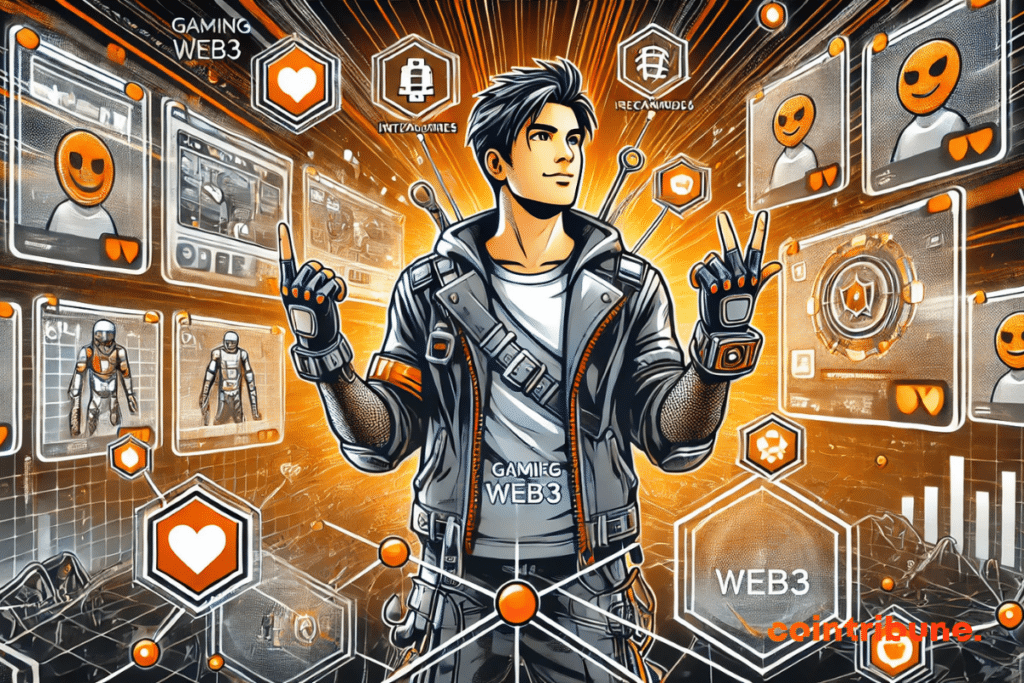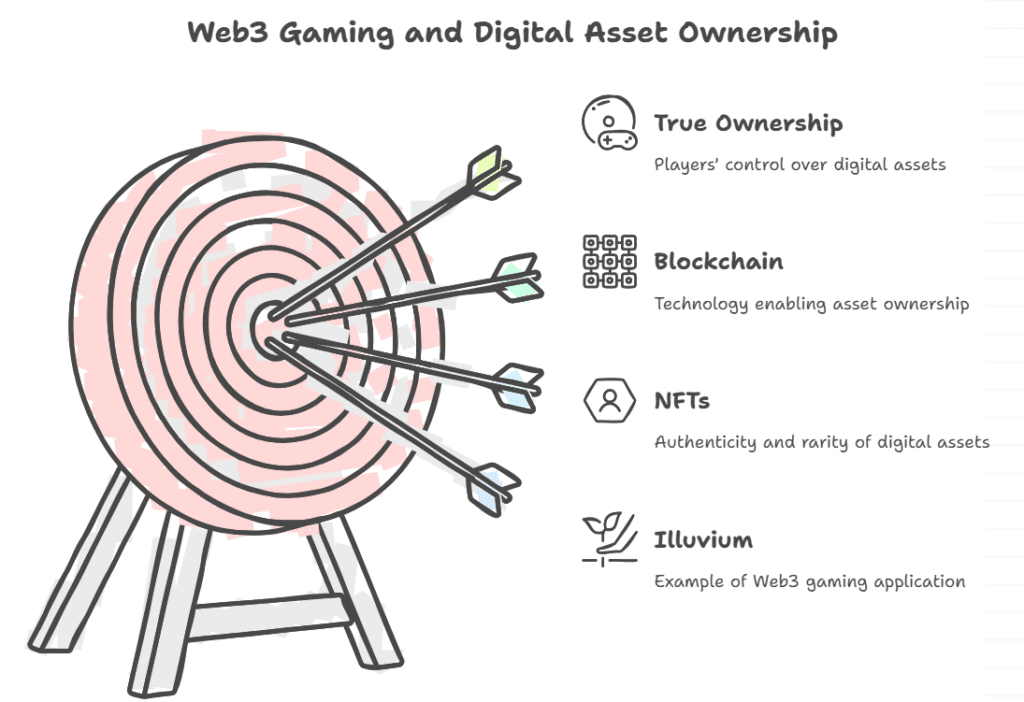What Are the Benefits of Web3 Gaming for Players?
The video game has evolved from the first consoles to connected virtual worlds. Innovations have transformed the player experience by integrating online features and virtual economies. Web3 brings a new revolution. It relies on blockchain, decentralization, and true ownership of digital assets. This technology allows players to control their items and interact directly with the game economy. This article explores the advantages of Web3 gaming. It highlights the opportunities available to players, particularly in terms of ownership, monetization, interoperability, and community engagement.

In brief
- Definition: Web3 gaming allows players to truly own their digital assets through blockchain while actively participating in the game economy.
- Ownership: Players control their items through verifiable and transferable NFTs across games.
- Monetization: Models like Play-to-Earn offer crypto revenues, with concrete examples like Axie Infinity or The Sandbox.
- Interoperability: Digital assets are compatible across multiple games and platforms, enhancing the continuity of experience.
- Engagement: DAOs and co-creation involve players in governance and game evolution.
- Security: Transactions are immutable and secure, with smart contracts ensuring reliable automation.
- Inclusion: Accessible to all, even without a bank account, Web3 gaming opens economic opportunities for populations excluded from the traditional financial system.
Digital ownership and asset control
Web3 gaming redefines the ownership of virtual items. Thanks to blockchain, players gain total control over their assets, regardless of game publishers.

Real possession of in-game assets
In traditional games, in-game items remain under the control of developers. Players cannot resell or transfer them outside the game. The blockchain changes this dynamic by granting true ownership to users. Each item belongs directly to the player, who can exchange or use it across compatible platforms.
Non-fungible tokens (NFT)
The NFTs authenticate digital assets. Each NFT represents a unique item, with ownership verifiable on the blockchain. This technology guarantees the rarity and value of virtual goods. It prevents fraudulent modifications and gives players the freedom to fully exploit their assets.
- Example: Illuvium
Illuvium illustrates this concept. This Ethereum-based RPG allows players to capture creatures called Illuvials. Each Illuvial is a unique NFT that can be upgraded or exchanged on decentralized markets. This approach offers players a new way to collect and invest in virtual assets without relying on a centralized publisher.
Economic opportunities and Play-to-Earn models
Web3 gaming introduces an innovative economic model. It allows players to earn financial rewards by participating in the game’s activities.

The Play-to-Earn (P2E) model
The Play-to-Earn (P2E) model turns gameplay time into a source of income. Players receive crypto or NFTs by completing missions, winning battles, or developing in-game assets. These rewards can be exchanged for real money, thus creating a decentralized virtual economy.
Case study: Axie Infinity
Axie Infinity perfectly illustrates the P2E model. Players breed and battle creatures called Axies, each represented as an NFT. Victories allow them to earn Smooth Love Potion (SLP) tokens, exchangeable on crypto platforms.
This game had a major economic impact, particularly in the Philippines, where some players used their earnings as their main source of income. However, the volatility of tokens and excessive speculation limited the model’s sustainability, leading to a drop in rewards and a decrease in player interest.
Other examples of P2E games
Other Web3 games adopt similar mechanisms. Gods Unchained rewards players with NFT cards that can be resold. The Sandbox allows for monetizing land and virtual experiences. These games offer new economic opportunities while diversifying the player experience.
Interoperability and open ecosystems
Web3 gaming offers players greater flexibility by making digital assets interoperable. This innovation allows the same items to be used across multiple games and platforms.

Transferability of digital assets
Web3 games use blockchain to standardize virtual items. Thanks to protocols like ERC-721 and ERC-1155, NFTs can be transferred between different environments. A player owning a weapon or NFT skin in one game can use it in another compatible title. This interoperability prevents asset loss and enhances the value of digital items.
Creation of interconnected ecosystems
The interoperability allows developers to build open ecosystems. Assets are no longer limited to a single game, promoting the integration of multiple universes. Some projects like The Sandbox and Decentraland offer spaces where users create and monetize reusable content in various games and applications.
This approach transforms game design. Studios collaborate to ensure the compatibility of their assets, thus creating a broader and more interconnected virtual economy.
Impact on user experience
Interoperability enhances player experience by offering them more freedom. They are no longer forced to start over when switching games. Items bought or earned retain their value and utility. This flexibility reinforces player engagement and attachment to the Web3 ecosystem, while providing better continuity between different gaming experiences.
Community engagement and decentralized governance
Web3 gaming transforms the relationship between players and developers. It promotes active user involvement in the management and evolution of games.
Increased participation of players
Web3 games integrate decentralized autonomous organizations (DAOs) to allow players to take part in decisions. Unlike traditional games, where updates and strategic directions depend on studios, DAOs grant voting rights to holders of governance tokens. Players thus influence choices regarding gameplay balancing, adding new features, or managing economic rewards.
Co-creation of content
Web3 paves the way for collaborative creation. Players can design skins, lands, or items usable in games. Some projects allow selling these creations as NFTs and generating income from them. This approach values the work of users and enhances community engagement.
Platforms like The Sandbox encourage this co-creation by providing players with tools to develop their own interactive experiences. This dynamic enriches the gaming universe while offering new economic opportunities.
- Example of a DAO in gaming
Decentraland utilizes a DAO to manage its virtual world. Owners of digital land participate in decisions regarding the evolution of the ecosystem. They vote on updates, resource management, and events organized within the metaverse. This model demonstrates how decentralized governance can shape a game based on players’ expectations.
Security and Transparency
Web3 gaming relies on blockchain to secure transactions and ensure transparency in game mechanics. This technology enhances players’ trust and protects their digital assets.
Transaction Security
The blockchain records each transaction immutably. Each exchange of assets, purchase of items, or transfer of tokens is validated by a decentralized network, preventing any fraudulent modification.
Players own their assets directly in their digital wallet. Unlike traditional games, where items remain stored on centralized servers, Web3 protects digital goods from hacking or the shutdown of a game. This security reduces the risks of theft and fraud.
Smart contracts ensure automatic execution of transactions. They guarantee that each transfer meets predefined conditions, thus avoiding human errors and malicious manipulations.
Transparency of Game Mechanics
The blockchain makes the rules and algorithms visible to all. Players can verify the rarity of an NFT, the fairness of random draws, and the functioning of in-game rewards. This transparency reduces the risks of manipulation by developers and enhances user trust.
Studios can no longer modify item drop rates or disable features without leaving a trace. Players thus benefit from a fairer and more reliable environment. This transparency strengthens community engagement and legitimizes the economy of Web3 gaming.
Accessibility and Financial Inclusion
Web3 gaming offers new opportunities to players around the world. It facilitates access to games and financial transactions, even for those excluded from traditional banking systems.
Global Accessibility
The blockchain allows players to participate in games without geographical restrictions. Unlike traditional platforms, which often impose limitations based on countries, Web3 games operate in a decentralized manner.
Crypto payments simplify access to in-game services. Players do not need a bank account to purchase items or exchange digital assets. This flexibility encourages the adoption of Web3 gaming in areas where financial services remain limited.
Smartphones and blockchain applications make these games accessible to a broader audience. Even without a powerful computer, players can interact with Web3 ecosystems and enjoy the economic benefits of decentralized games.
Financial Inclusion
Web3 gaming creates economic opportunities for marginalized populations. Play-to-Earn models allow players to generate income while playing. In some regions, these earnings supplement a salary or replace unstable sources of income.
NFTs and cryptos provide a alternative to unstable local currencies. Players can store and exchange their digital assets without relying on a banking system. This financial independence enhances their ability to participate in the global economy and invest in sustainable digital opportunities.
Web3 gaming transforms the player experience by introducing digital ownership, interoperability, and new economic opportunities. It allows for owning in-game assets, exchanging NFTs, and earning cryptos. Its decentralized model enhances transparency, security, and community engagement. Global accessibility and financial inclusion open the market to new players. The evolution of blockchain technologies and increasing adoption by the industry will foster its development. If regulatory and environmental challenges find suitable solutions, Web3 could sustainably redefine the video game industry and provide players with a freer and fairer experience.
FAQ
Yes, because blockchain and on-chain transactions require network access to validate exchanges and interact with smart contracts. Some games offer offline features, but most require an active connection.
No, digital assets like NFTs remain stored on the blockchain and can be used on other compatible platforms. However, their usefulness depends on adoption by other games and ecosystems.
No, more and more Web3 games are simplifying the user experience by integrating built-in wallets and fiat payment options. Accessibility is improving to attract a broader audience.
Maximize your Cointribune experience with our "Read to Earn" program! For every article you read, earn points and access exclusive rewards. Sign up now and start earning benefits.
Diplômé de Sciences Po Toulouse et titulaire d'une certification consultant blockchain délivrée par Alyra, j'ai rejoint l'aventure Cointribune en 2019. Convaincu du potentiel de la blockchain pour transformer de nombreux secteurs de l'économie, j'ai pris l'engagement de sensibiliser et d'informer le grand public sur cet écosystème en constante évolution. Mon objectif est de permettre à chacun de mieux comprendre la blockchain et de saisir les opportunités qu'elle offre. Je m'efforce chaque jour de fournir une analyse objective de l'actualité, de décrypter les tendances du marché, de relayer les dernières innovations technologiques et de mettre en perspective les enjeux économiques et sociétaux de cette révolution en marche.
The views, thoughts, and opinions expressed in this article belong solely to the author, and should not be taken as investment advice. Do your own research before taking any investment decisions.